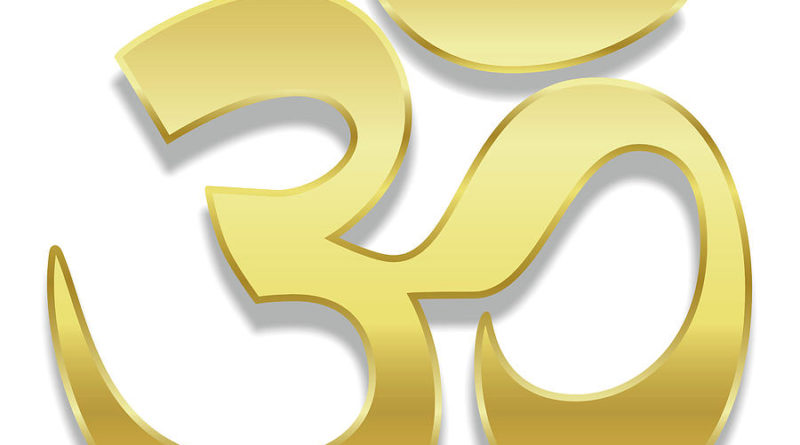IMPORTANCE OF CHANTING OM
OM, written in Devanagari and Aum written in Sanskrit, known as Pranava or Omkara is a mystical or sacred syllable in Hinduism, Buddhism and Jainism. It is placed at the beginning of most Hindu Texts as a sacred incantation to be intoned at the beginning and end of a reading of the Vedas or prior to any Prayer or Mantra. The Mandukya Upanishad is entirely devoted to the explanation of the Syllable. The Syllable is taken to consist of three phonemes -A, U and M, variously symbolizing the three Vedas (Rig-Veda, Sam Veda, and Yajur Veda) or the Hindu Trimurti -Brahma, Vishnu and Shiva- or the three stages of life -birth, life and death. The name Omkar is taken as a name of God in the Hindu revivalist Arya Samaj. Omkara has a universal sound & can be heard all around in the surrounding nature. The meaning of the syllable Om is different to different persons. Everyone gives it the meaning that suits him best. Om is a combination of three sounds ‘A’, ‘U’ and ‘M’. The ‘A’ sound stands for the state of wakefulness, where one experiences externally through one’s mind and sense organs. The ‘U’ sound stands for the dream state, in which inward experiences are available. In the state of deep sleep, represented by the sound ‘M’ sound, there is no desire and consciousness is gathered in upon itself. But there is a fourth transcendent state (Turiya Avastha) corresponding to silence. As the other three correspond to AUM, Turiya Avastha is a completely integrated state of being. If one identifies the wordless state with Turiya and Meditates, one realizes one’s true self. A, U and M cover the whole range of sound vibrations. The larynx and the palate are the sounding boards. When you pronounce A, no part of the tongue or palate is touched. When you pronounce U the sound rolls from the very root to the end of the sounding board of the mouth. M is the last sound which is produced by closing the two lips. ‘A’, the first sound, is produced as a pure, open column of air rising from the abdomen and issuing unobstructed through the mouth. ‘U’ raises the sound to the back of the throat, while the nasalized ‘M’, intoned with lips closed, carries the vibrations upwards and inwards to stimulate Sahasrara Chakra. The state of Turiya is then experienced after the physical sound is terminated, but before the next inhalation, in that period of suspension of the breath. In this way the chanting of long drawn out ‘A – U – M’ with concentration on the source of each sound element can carry one through the different states of consciousness into the silence of the final Kumbhaka (Retention). Omkar is a journey from Manipur to Sahasrar (the names of the centers in our body) -lowest and highest.Sit in a steady and comfortable posture. Keep your spine and head erect. Close your eyes gently. Relax all the muscles. Make sure the body and mind are relaxed. Now keep your right hand on the abdomen. Do the prolonged pronunciation of Omkar for once. See what has happened to the abdomen. The abdomen wall moves in till the pronunciation of Om continues and it moves out as it is completed. This way by doing Omkar, the abdomen connects both throat and nose. While chanting AUM, we can feel its effects on the navel, the heart and the head. The first pronunciation A (Akara) creates the vibrations, which affects spinal cord to increase its efficiency. The second pronunciation U (Ukara) creates the vibrations in the throat and affects the thyroid and parathyroid glands. The last pronunciation M (Makara) brings the vibrations to the brain via nose. The nasal part of the pronunciation has effect on the head. Therefore Omkar does the reawaken of the cerebrum and cerebellum thus increasing brain’s efficiency.Omkarkar is our first Pranayama. There is no scientific training necessary for practice of Omkar. It is a very simple but powerful Pranayama. It has no side effects. Anybody can chant Omkar any time of the day or night, whenever the belly is not full. Inhale slowly and deeply through the nose. Open the lips and start chanting ‘O’ slowly but loudly. Close your lips completely and pronounce ‘M’. When we chant Omkar A and U join together and the sound becomes ‘O’. In this pranayama AU is prolong and M is short. Normally we breathe in for 12 to18 times in a minute in a comfortable sitting position. There is a saying that we breathe for twelve times in a sitting position, for eighteen times during walking, for forty times while running and for seventy two times during anger. But on an average we take breath for fifteen times every minute. So it is one breath for every four seconds. We breathe in and out in these four seconds. While doing Omkar Pranayama we breathe only 3 to 4 times in 1 minute. It means we do Omkar for four times in a minute, each is for 15 seconds. So the pronunciation of one Omkar takes fifteen seconds. In this way, we are saving 11 breaths & are getting 11 seconds extra oxygen with one breath. It implies saving of 11×4 = 44 seconds in one minute. If we practise Omkar for five minutes we’ll get extra oxygen for 44×5 =220 seconds. Practising of Omkar for 15 minutes at one time will thus save 220×3=660 seconds or 11 mints. Hence if we practice Omkar three times a day (each time 15 mints), we can save a total of 11×3=33minutes. The purification of blood occurs by so much extra oxygen. It will be excellent if we practice Omkar for five minutes to start with and gradually increase it to twenty minutes in the morning after waking up. By regular and lifelong practice of Omkar increases positive energy and gives us healthy, long & balanced life. The control of our blood pressure, emotions and the cooling down of anger is possible.Mulabandha means contraction and puling in of the muscles surrounding anal canal. Mula Bandha, when engaged, prevents Apana escaping from the lower body and draws it up to unite with Prana. Because of the pressure on the anal sphincter, during Mula Bandha, heat is generated which causes Apana Vayu to move upward. The usual tendency of this Vayu is to move ownward. However, this practice forces Apana to move upward and unite with Prana Vayu at the navel centre. When we practice Omkar and practice Mulabandha simultaneously the physical, mental, and psychic bodies leads to in preparation for spiritual awakening. Mulabandha should not be performed wrongly. Chanting OM creates detachment and empowers all mental and spiritual processes. It can take you all the way to deep states of Yoga, if you have good concentration. Why we chant Om three times at the beginning and end of a class. Every teacher has different answer. Some say for peace in the physical dimension, the mental dimension and the spiritual dimension. But the real reason is concentration on the Granthis. The word Granthi means ‘knot’. The Yogic system recognizes three Granthis or knots in our bodies. The first is Brahma Granthi, the knot of Brahma, the creator, at Mooladhara Chakra. When you chant Om the first time, always have your awareness at Mooladhara. Mooladhara is responsible for creation. Our consciousness is stuck in Mooladhara, in the world of matter. The second knot is Vishnu Granthi at Manipura Chakra. When you chant Om the second time, bring your attention from Mooladhara to Manipura. The third is Rudra Granthi, the knot of Rudra, the transformer, the destroyer, the re-emergence of consciousness, rising of the phoenix from the ashes to Ajna Chakra, rebirth. When you chant Om the third time, bring your attention to Ajna Chakra, the eyebrow centre. Stop for at least five seconds at each of the three Chakras and become aware of light there. In time the quality of your experience will change. It may take a week or a month, but you will notice a great difference. When we chant Aum seven times, each chanting of Aum can be visualized in all the seven Chakras, with a five second pause in between each one. When we practise three times in Mooladhara, Manipura and Ajna, it is ‘O-M’. When we practise seven times, it is ‘A-U-M’.Regular practice of Omkar in the morning, afternoon and evening increases the breathing capacity, circulatory capacity, digestion power, functioning capacity of excretory system and nervous system significantly. The newer vitality, pleasure, freshness and enthusiasm are the results of the practice of Omkar. Om is a panacea or sovereign remedy for all ailments. All pathogenic or disease-causing germs are destroyed or burnt by the vibrations of Om (pic courtesy to Anita Goa).





I really appreciate for great knowledg thank you sir
Excellent and practical explanation